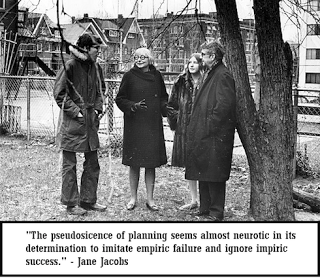By Jane Jacobs (1916-2006), from Chapter 2 of The Death and Life of Great American Cities.
Under the seeming disorder of the old city, wherever the old city is working successfully, is a marvelous order for maintaining the safety of the streets and the freedom of the city. It is a complex order. Its essence is intricacy of sidewalk use, bringing with it a constant succession of eyes. This order is all composed of movement and change, and although it is life, not art, we may fancifully call it the art form of the city and liken it to dance - not to a simple-minded precision dance with everyone kicking up at the same time, twirling in unison and bowing off en masse, but to an intricate ballet in which the individual dancers and ensembles all have distinctive parts which miraculously reinforce each other and compose an orderly whole. The ballet of the good city sidewalk never repeats itself from place to place, and in any one place is always replete with improvisations.
The stretch of Hudson Street where I live is each day the scene of an intricate sidewalk ballet. I make my own first entrance into it a little after eight when I put out the garbage can, surely a prosaic occupation, but I enjoy my part, my little clang, as the droves of junior high school students walk by the center of the stage dropping candy wrappers. (How do they eat so much candy so early in the morning?)
The heart-of-the-day ballet I seldom see, because part of the nature of it is that working people who live there, like me, are mostly gone, filling the roles of strangers on other sidewalks. . . . Mr. Lacey, the locksmith, shuts up his shop for a while and goes to exchange the time of day with Mr. Slube at the cigar store. Mr. Koochagian, the tailor, waters the luxuriant jungle of plants in his window, gives them a critical look from the outside, accepts a compliment on them from two passers-by, fingers the leaves on the plane tree in front of our house with a thoughtful gardener's appraisal, and crosses the street for a bite at the Ideal where he can keep an eye on customers and wigwag across the message that he is coming. The baby carriages come out, and clusters of everyone from toddlers with dolls to teen-agers with homework gather at the stoops.
When I get home after work, the ballet is reaching its crescendo. This is the time of roller-skates and stilts and tricycles, and games in the lee of the stoop, . . . the time of bundles and packages, . . . teen-agers all dressed up, . . . this is the time when anybody you know around Hudson Street will go by.

As darkness thickens and Mr. Halpert moors the laundry cart to the cellar door again, the ballet goes on under lights, eddying back and forth but intensifying at the bright spotlight pools of Joe's sidewalk pizza dispensary, the bars, the delicatessen, the restaurant and the drug store. The night workers stop now at the delicatessen, to pick up salami and a container of milk. Things have settled down for the evening but the street and its ballet have not come to a stop.
. . . .
Deep in the night, I am almost unaware of how many people are on the street unless something calls them together, like the bagpipe. Who the piper was and why he favored our street I have no idea. The bagpipe just skirled out in the February night, and as if it were a signal the random, dwindled movements of the sidewalk took on direction. Swiftly, quietly, almost magically, a little crowd was there . . . a circle with a highland fling inside it. . . . When he finished and vanished, the dancers and watchers applauded, and applause came from the galleries, too, half a dozen of the hundred windows on Hudson Street. Then the windows closed, and the little crowd dissolved into the random movements of the night street.
The strangers on Hudson Street, the allies whose eyes help us natves keep the peace of the street, are so many that they always seem to be different people from one day to the next. That does not matter. . . . When you see the same stranger three or four times, you begn to nod. This is getting to be an acquaintance. . . .
I have made the daily ballet of Hudson Street sound more frenetic than it is, because writing telescopes it. In real life, it is not that way. In real life, to be sure, something is always going on, the ballet is never at a halt, but the general effect is peaceful and the general tenor even leisurely. People who know well such animated city streets will know how it is. I am afraid people who do not will always have it a little wrong in their heads—like the old prints of rhinoceroses [drawn based on] travelers' descriptions of rhinoceroses.
On Hudson Street, the same as in the North End of Boston or in any other animated neighbourhoods of great cities, we are not innately more competent at keeping the sidewalks safe . . . . We are the lucky possessors of a city order that makes it relatively simple to keep the peace because there are plenty of eyes on the street.